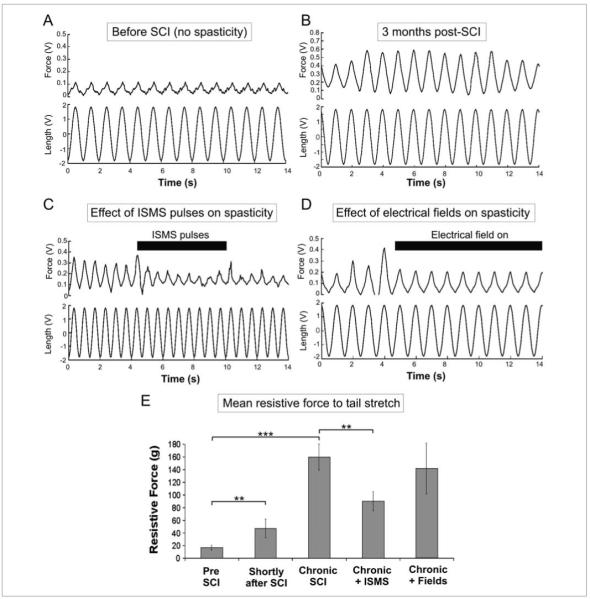Figure 3.
Effects of electrical stimulation techniques on the level of spasticity after spinal cord injury (SCI). Spasticity was assessed by measuring the tail-resistive forces through a force transducer connected to the rat tail, in response to sinusoidal side-to-side tail stretches. (A) Low tail-resistive forces measured from an adult intact rat, that is, no spasticity (control condition). (B) higher tail-resistive forces measured from an adult rat with chronic SCI at S2/S3 in response to the same level of sinusoidal tail stretches. (C) Intraspinal microstimulation (ISMS) current pulses (suprathreshold high-frequency sinusoidal pulses: 120 μA, 5 kHz) delivered through 4 microwires implanted in the sacral cord below the lesion of an adult rat with chronic (3 months) spinal injury; injection of ISMS pulses reduced the tail-resistive force in response to tail stretches. (D) AC electrical field (1 Hz, 100 mV/mm) applied along the mediolateral axis of the spinal cord through external metal plates during tail stretches of a chronic spinal rat (3 months) with spasticity; application of the electrical field slightly reduced the tail-resistive force. (E) Summary of mean tail-resistive forces in response to tail stretches under different conditions (before SCI, 3 weeks after SCI when spasticity was not fully developed, chronic SCI when spasticity was fully developed, chronic SCI during the injection of ISMS current pulses, and chronic SCI during the application of electrical fields). In these experiments, the fields were applied through external plates positioned noninvasively on the outside of the rat. The effectiveness of the fields is expected to increase substantially when applied through the metal plates/rods used to stabilize the spine. Data presented as mean ± SD. Asterisks represent the statistical significance level: **P < .01; ***P < .001.

